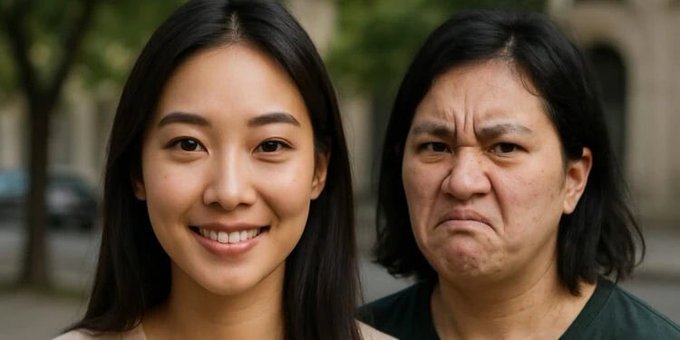Contrast is critical in art and psychology.
https://finearttutorials.com/guide/contrast-in-art/
https://x.com/OwenGregorian/status/1930589546133283152
Ugly bystanders boost beauty: Study finds background faces shape personality judgments | Eric W. Dolan, PsyPost
New research published in Current Psychology suggests that people form more positive impressions of a face when it appears alongside others, and that the emotional impact of surrounding faces plays an important role in shaping these impressions. The study found that even moderately attractive faces were judged more favorably when paired with less attractive ones, a phenomenon linked to emotional brain responses measured through electrical activity.
Researchers conducted the study to investigate how people evaluate personality traits from faces in social situations where more than one face is visible. Most previous research has focused on isolated face judgments, often finding that people associate facial attractiveness with positive characteristics like kindness, confidence, or intelligence. But real-life situations rarely involve judging faces in isolation. The authors wanted to understand whether the attractiveness of nearby faces might affect how a person is perceived, especially in cases where one face stands out from the others.
The research team used a neuroscience method called event-related potentials (ERP) to measure brain responses during trait inference. Specifically, they examined how participants responded to pairs of faces with differing attractiveness levels and how that affected their judgments about the target face. Participants were shown pairs of female faces—one moderately attractive and one either highly or lowly attractive—followed by a word describing a personality trait. They were then asked to judge whether the word matched the personality of the indicated target face. The brain’s response to the word was recorded, particularly looking at components related to emotional processing and semantic conflict.
A total of 47 college students (aged 18–24) participated in the study, all of whom were right-handed, had normal or corrected vision, and reported no history of neurological or psychiatric disorders. One participant was excluded due to excessive noise in the EEG data. Each participant completed 80 trials in which they viewed pairs of faces and then judged whether a trait word was a good fit for one of the faces. The researchers focused on “medium attractiveness” faces as targets and paired them either with highly attractive or lowly attractive background faces. Importantly, the target face was always of medium attractiveness, while the paired face varied in attractiveness.
The study used a total of 160 female face photographs, pre-rated for attractiveness by an independent group. Each photo was edited to remove external features like hair and accessories, ensuring that judgments were based on facial structure alone. The trait words used in the study consisted of five positive traits (such as “kind” and “friendly”) and five negative traits (such as “rigid” and “indifferent”). Participants responded by indicating whether they believed the trait word described the face.
The results showed that participants were generally more likely to associate target faces with positive traits than with negative ones. Across all conditions, 66% of positive trait words were judged as matching the target face, compared to only 29% of negative trait words. But a more interesting pattern emerged when the background face’s attractiveness was taken into account. The difference in positive versus negative judgments was significantly larger when the background face was unattractive compared to when it was attractive. In other words, participants were more likely to view the moderately attractive target face as especially positive when it was paired with a less attractive face.
The researchers also looked at reaction times. Participants responded faster when the background face was low in attractiveness compared to when it was high. This suggests that the emotional impact of the pairing may have made trait judgments easier in some contexts. To explore this further, the study examined specific ERP components—brain signals that reflect how people process information.
One key component, the N400, is linked to detecting mismatches between expectations and actual input. When a word doesn’t semantically fit with a previous stimulus—like an unexpected trait description following a face—the N400 amplitude becomes more negative. In this study, the N400 was significantly larger for negative trait words than for positive ones, indicating greater conflict when participants had to associate a negative word with a target face. This suggests that faces were generally being interpreted as more consistent with positive traits, especially when paired with other faces.
Another component of interest was the late positive potential (LPP), which reflects emotional engagement. Here, the researchers found a significant difference: low attractiveness background faces elicited a stronger emotional response, as reflected in larger LPP amplitudes. This heightened emotional response may explain why trait inferences about target faces became more positive in those contexts. Notably, early-stage components related to face detection and attention (N170 and EPN) did not differ significantly between conditions, suggesting that the emotional influence emerged later in the processing sequence.
The findings point to a dynamic interplay between visual context, emotional response, and social evaluation. When people see multiple faces, their judgments about one face are shaped not just by that face’s features, but also by how it compares to the others and the emotional reactions those comparisons evoke. Interestingly, less attractive background faces had a stronger influence than highly attractive ones, possibly due to the greater emotional contrast they created. This pattern supports the idea that emotional processing plays a central role in how people evaluate others, even when they are not explicitly aware of doing so.
The study offers a new angle on the well-known “beauty is good” stereotype by showing that judgments can be context-dependent and influenced by emotional cues from surrounding faces. While attractive people are still generally seen more favorably, this favorability can extend to others when the context involves unflattering comparisons. Emotional responses to background faces may amplify or soften how target faces are perceived, especially when the observer is processing multiple faces simultaneously.
Read more:
https://psypost.org/ugly-bystanders-boost-beauty-study-finds-background-faces-shape-personality-judgments/…





No comments:
Post a Comment